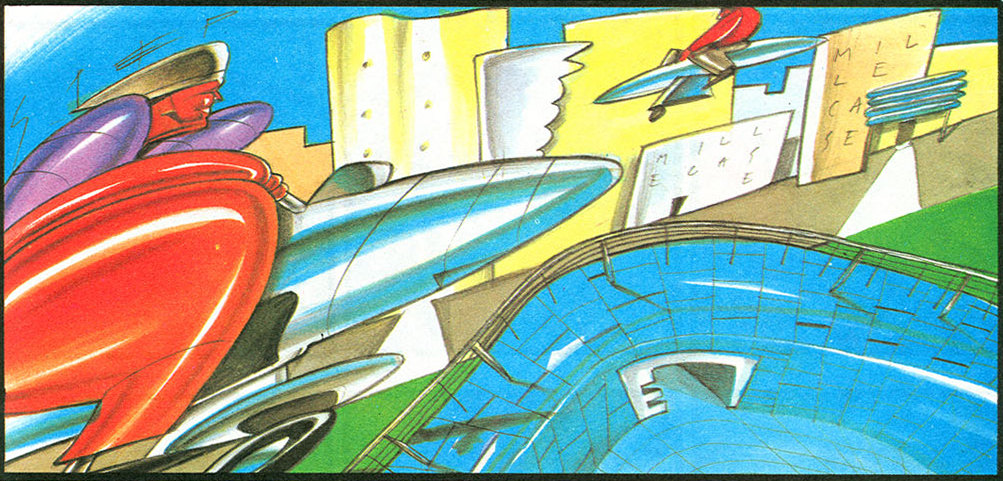|
|
An Essay on the Essential Elements of our New Technology by Massimo Iosa Ghini. 1986
Massimo Iosa Ghini (born June 18, 1959) is an Italian architect, designer and professor known for pioneering the Bolidist Movement, and for his involvement with the Memphis Group featuring others architects including Ettore Sottsass, Michael Graves. Iosa Ghini is known for his streamlined and organic designs, and is praised for his “visionary ability to blend disciplines, forms and dimensions crossing boundaries in art, design, and architecture.” He has worked prolifically throughout the world and has designed a large collection of furniture that mirrors the futuristic designs of his architectural work. In 1990 he started the Iosa Ghini Associati (Associates) Firm which today operates out of Milan, Bologna, Moscow and Miami.
The Bolidist Movement, which appeared in 1986, is recognizable by its streamlined forms and computerized cartoon images (as in work of Massimo losa Ghini and Maurizio Corrado). Its celebration of speed and smoothness of technology, as well as of mental and physical mobility, brings it close to the futurist inspiration.
Iosa Ghini is considered one of the Fathers of Bolidism, a style which he sums up as “a way of narrating the transition from materialety to drawing things in which the visual and media aspect prevails with respect to the object’s functional purpose”. It can be described as a colorful style that borrows elements from futurism, and is fascinated with human and machine interaction.
An Essay on the Essential Elements of our New Technologyby Massimo Iosa Ghinifrom the Heavy Metal, 1986 Winter
Ministry of internal affairs
We are writing this communiqué on paper instead of sending it to you via the airwaves because we would like to honor that ancient means of communication: the printed sheet. We hope this will be to your liking.
In 1991, after the videobuilders had absorbed all they could from the tenets of ancient futurist architects, they started studying Mandrake and the superlogistics of Flash Gordon, searching for new fonts of streamlined inspiration.
With the teachings of Morris, Gropius and Menoni still fresh in their memories, the videobuilders established hypertechnology and aesthetics as the asymptotes of their new, imaginative enterprises, thus affirming once and for all their freedom from the obsession of form and function.
By pushing the tenets of the Bauhaus one step further, architects in the Orient came up with a new conceptual prototype of the building comprising a roof, a light steel structure and an elevated and elasticized floor. A universal system, prefabricated, on which to place the wildest and most spectacular shapes.
Inside the new prototypes is a splendid emptiness, the only objects left are those strictly necessary for survival: a. stove, b. refrigerator, c. home computer, d. video-television-projector, e. intercontinental cable-telephone, f. climatic control.
From the building prototype to the human body: the prosess starts all over again. We are now able to project all sorts of shapes and fashions on our bodies, thanks to the micronized laser-projectors who dress us with any fashionable image we might desire.
The applications of these marvelous machines are manifold: for instance, some men have been able to resolve their problems having to do with personal appearance.
Body climatization is assured via non-carcinogenic, portable self-rayons, which guarantee the invulnerability of all solid parts of the body.
All women are now beautiful. The Martin self-beauty adapter leaves ample creative possibilities as far as body and face are concerned. At this moment the most popular faces are those of the Hollywood stars of the 1940's.
The tie is the only object which has remained untouched by this revolution. It has kept with the tradition established in 1984, the year in which the tie became both a means of identification and a status symbol.
There are 17 different types produced, solo in 6,250,000 color variations. All ties are now designed by Massimo Zaddu, who invented the layered tie and "beach-tie" architecture. As a point of interest, both are very popular in Georgia, where Zaddu designed a whole city with his hyperbolic magnetic pencil.
The End
9 апреля 2020, 10:17
0 комментариев
|
Партнёры
|











Комментарии
Добавить комментарий